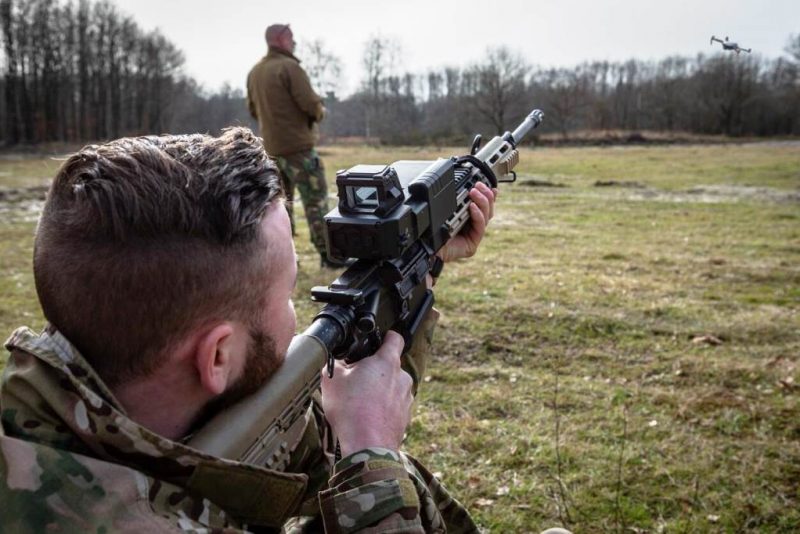The Army is officially adopting a ‘guaranteed hit’ smart scope
One shot, one kill — every time.
By Jared Keller
Task & Purpose
October 7, 2022

 An Israeli startup company by the name of Smart Shooter has developed an IsSMASH system that can be attached to any rifle as long as it has the appropriate M1913 Picatinny rails for optics and a forward pressure switch location.
An Israeli startup company by the name of Smart Shooter has developed an IsSMASH system that can be attached to any rifle as long as it has the appropriate M1913 Picatinny rails for optics and a forward pressure switch location.
After years of testing, the Army is officially adopting a specially designed computerized fire control and optic system that will allow troops to lock on to incoming drone threats with their standard-issue rifles and disable them with a single accurate shot.
The SMASH 3000 uses “target acquisition and tracking algorithms are integrated with sophisticated image-processing software” to allow the scope to easily lock onto targets at up to 200 meters away and ensure shot accuracy despite human factors like “fatigue, stress or target movement,” according to the system’s spec sheet.
“Once you’ve locked on the target and you engage the fire control function, it will automatically calculate the ballistic solution to the target, but the round will not release until you have a 100% solution,” Scott Thompson, vice president and general manager of U.S. operations for Smart Shooter, previously told Task & Purpose.
Weighing just 1.63 pounds, the SMASH 3000 is a lighter version of the 2.6-pound SMASH 2000 system tested by U.S. forces in the past, compatible with both the M4 carbine and the M110 Semi-Automatic Sniper System (M110 SASS) and capable of 72 hours of activity “or up to 3,600 SMASH-assisted shots” before needing to recharge, according to the system’s spec sheet.
Smart Shooter claims that the SMASH 3000 system will be fielded to “Army divisions” as part of the service’s broader push to modernize its counter-drone capabilities. (The Army’s PEO Soldier office did not immediately respond to a request for details regarding the SMASH 3000’s adoption and fielding).

The proliferation of weaponizable commercial drones among foreign adversaries has become an acute threat to U.S. forces deployed downrange. In 2019, the amphibious assault ship USS Boxer was engaged by a pair of Iranian drones while deployed to the Strait of Hormuz, leading sailors and Marines to use a drone jammer mounted on a combat buggy on its deck to deal with the hostile systems.
The following year, the head of U.S. Central Command revealed that unidentified drones in Syria had been dropping explosives on some of the 900 U.S. troops deployed there, a development that the then-head of U.S. Central Command later called the greatest threat to U.S. troops downrange since the improvised explosive device.
“These systems are inexpensive, easy to modify and weaponize, and easy to proliferate,” then-CENTCOM chief Marine Gen. Kenneth McKenzie Jr. said in 2021. “They provide adversaries the operational ability to surveil and target U.S. and partner facilities while affording plausible deniability and a disproportionate return on the investment, all in our adversaries’ favor.”
That proliferation has led the Army to initiate a surge in its counter-drone capabilities. Indeed, the Army initially approved the SMASH system alongside several other vehicle-mounted and handheld anti-drone weapons “to address urgent and emerging operational needs of deployed forces” back in 2020.
The SMASH system is currently in operational use by the Israeli Defense Forces, Indian Navy, and “forces from NATO and Europe,” according to Smart Shooter.
“We are [honored] that the US Army continues to value our true fire control systems, and once again selects the SMASH technology for the use of its soldiers,” Michal Mor, current CEO, said in a statement. “Whether mounted on a rifle or remotely controlled, the unique SMASH technology ensures precise target elimination by guaranteeing that shot accuracy will not be affected by human errors such as fatigue and stress, nor by the target movement.”
1 comment:
This technology has been around for some time. It was secretly used against Somali Pirates by the Navy and Coast Guard MSRT. Those so-called impossible shots against Pirates who were holding hostages were not lucky shots.
Post a Comment